
Ghost Hunting with Electromagnetic Fields
Ghost hunters tend to use EMF meters … a lot … when looking for signs of a ghostly manifestation. But do they really know what EMF means and all the ‘gotchas’ that come along with them? Get the scoop on using EMF after the jump.
Table of contents
- What Are Electromagnetic Fields?
- Types of Electromagnetic Fields
- Why Ghost Hunters Are Interested in EMFs
- The History of EMF in Ghost Hunting
- The Theory Behind EMF and Ghosts
- Tools of the Trade
- Establishing Baseline Readings
- Triggering Responses with EMF Tools
- Challenges with EMF Meters
- Potential False Positives
- Common Sources of False EMF Readings
- Ghost Hunting Best Practices to Avoid False Readings
- Practical Tips for Using EMF Meters in Investigations
- Establish Baseline Readings
- Minimize Electromagnetic Interference
- Repeating Measurements for Verification
- Cross-Reference Data with Other Devices
- Ask Spirits to Interact
- Control for Human Factors
- Time of Day and Environmental Conditions
- Use Multiple EMF Meters
- Don’t Jump to Conclusions
- Have Fun but Stay Safe
- Conclusion
What Are Electromagnetic Fields?
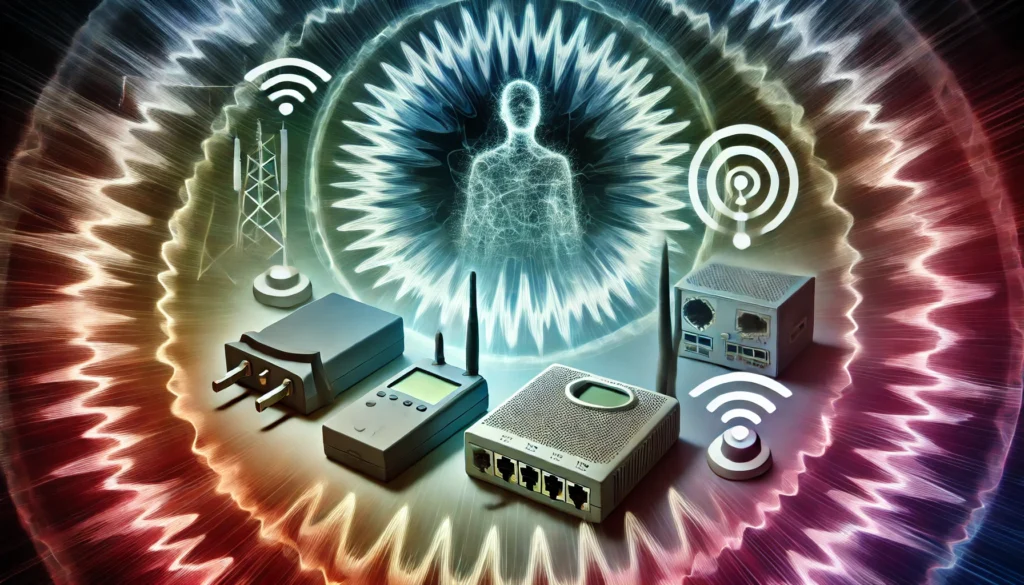
Electromagnetic fields (EMF) are a fundamental part of our physical world. To understand why ghost hunters are so interested in them, it’s important to first understand what EMFs actually are.
Electromagnetic Fields Explained
At their core, electromagnetic fields are areas of energy produced by electrically charged objects. Whenever electricity flows, it generates a magnetic field. These fields are present all around us, produced by everything from household electronics to natural processes. The electromagnetic spectrum, which includes everything from radio waves to gamma rays, covers a wide range of energy types.
Types of Electromagnetic Fields
There are two main types of electromagnetic fields:
Natural Sources of EMF
The Earth’s Magnetic Field: The Earth itself generates a massive magnetic field that we depend on for navigation and communication. This is why compasses point north; they align with Earth’s magnetic field.
Lightning and Solar Activity: Lightning strikes and solar activity also produce significant electromagnetic radiation. Natural minerals like magnetite can create localized magnetic fields as well.
Man-Made Sources of EMF
Power Lines and Electrical Devices: Everyday items like cell phones, televisions, computers, and power lines emit EMF. The field strength varies depending on the distance from the source and the power of the device.
Wi-Fi Routers and Smart Appliances: Modern technology, such as Wi-Fi routers and even household appliances like microwaves, emit electromagnetic fields. These sources create what are called extremely low frequency (ELF) EMFs.
Why Ghost Hunters Are Interested in EMFs
The connection between EMFs and ghost hunting stems from the theory that spirits may either emit their own energy or disrupt existing electromagnetic fields. Ghost hunters use EMF meters to measure these fluctuations, believing that spikes in EMF readings may indicate paranormal presence. Whether it’s ghosts manipulating energy to manifest or simply moving through space, ghost hunters often see changes in EMF as a potential indication of activity.
While this connection hasn’t been scientifically proven, many investigators believe that unusual EMF fluctuations could suggest something beyond the physical realm. For this reason, measuring EMFs has become one of the staple methods for ghost hunters seeking evidence of paranormal events.
The History of EMF in Ghost Hunting
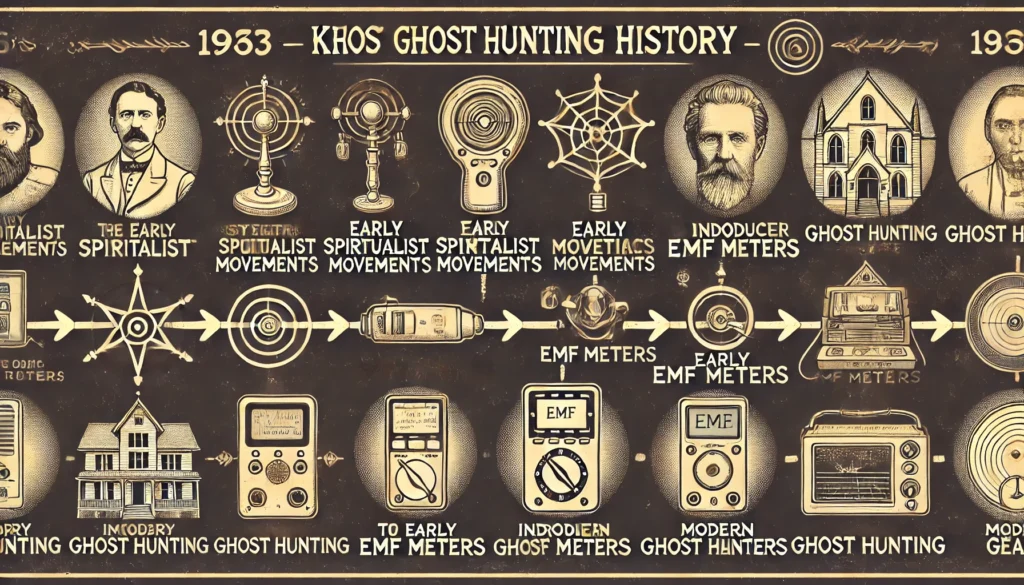
The use of electromagnetic fields in ghost hunting is a relatively recent development in the long history of paranormal investigation. To understand why EMF meters have become a staple in ghost hunters’ toolkits, it helps to look at how and when this practice began.
The Beginnings: Scientific Curiosity Meets the Paranormal
The idea of using technology to detect ghosts gained popularity during the spiritualist movement of the late 19th and early 20th centuries, a time when people were fascinated by séances, mediums, and the spirit world. This period laid the groundwork for the use of scientific instruments in ghost hunting. At that time, the technology wasn’t advanced enough to measure electromagnetic fields, but it spurred an interest in using emerging scientific tools to validate paranormal claims.
The link between ghosts and electromagnetic fields truly began in the 1970s, as scientific and technological curiosity about the paranormal continued to grow. Researchers like Dr. Michael Persinger began to investigate the possible relationships between magnetic fields and human perception of paranormal experiences. Persinger’s experiments, such as using weak magnetic fields on the brain to induce ghostly sensations, opened the door to thinking that electromagnetic fields could be connected to spiritual activity. These early experiments were pivotal in establishing the use of EMF as a point of study for paranormal researchers.
The Popularization of EMF Meters
In the 1980s, with the growing interest in investigating hauntings scientifically, ghost hunters started using electromagnetic field meters, tools originally intended for electricians and engineers to detect electromagnetic pollution. The TriField Natural EM Meter, which could detect changes in natural electromagnetic and radio fields, became one of the first meters adapted for paranormal investigation. Paranormal investigators noticed correlations between EMF fluctuations and reports of ghostly encounters, which fueled interest in using EMF meters as a staple tool for ghost hunting.
The Role of TV and Pop Culture
The widespread use of EMF meters in ghost hunting exploded in the early 2000s, largely thanks to paranormal reality TV shows like “Ghost Hunters” and “Paranormal State”. These shows featured investigators using EMF meters to locate paranormal hotspots in haunted locations, often portraying spikes in readings as evidence of spirits. The K-II meter, a simple EMF detector originally used for electrical work, was popularized by “Ghost Hunters” and quickly became a must-have gadget for paranormal enthusiasts.
These shows introduced a mass audience to the concept of detecting ghosts using science and gadgets, leading to the mainstream association of EMF meters with ghost hunting. The portrayal of investigators excitedly following fluctuating EMF readings as if they were hot on the trail of a ghost captivated viewers and firmly embedded the belief in the relationship between ghosts and electromagnetic fields in popular culture.
Recent Advances in Ghost Hunting Technology
In recent years, technology has continued to evolve, and ghost hunters now use a variety of specialized EMF detectors to capture data during investigations. Some devices, like the REM Pod, have been designed specifically for paranormal investigation, incorporating EMF sensors that emit alerts when the surrounding electromagnetic field is disrupted. Additionally, multi-sensor tools that combine EMF detection with temperature, humidity, and motion sensors have become increasingly common, making it easier for investigators to correlate EMF changes with other environmental factors.
While the link between ghosts and EMF is still debated, the use of these tools has helped shift ghost hunting from purely subjective experiences toward a practice that seeks to record measurable data. The ongoing interest in understanding the nature of electromagnetic fields and their connection to ghostly activity has made EMF meters a standard part of the ghost hunter’s toolkit, even if the definitive proof of their effectiveness remains elusive.
The Theory Behind EMF and Ghosts
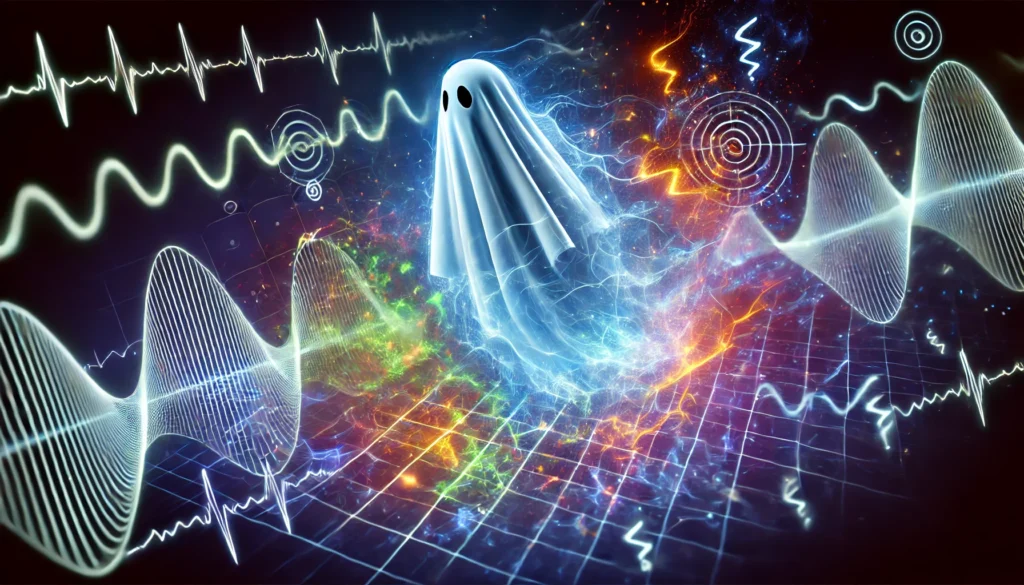
The belief that electromagnetic fields (EMF) play a role in ghostly activity is a central tenet of modern paranormal investigation. While there is no definitive scientific proof connecting ghosts with EMF, there are a few theories that explain why ghost hunters use these tools and what they hope to find. Let’s explore why electromagnetic fields have become a key piece in the puzzle of paranormal research.
Theory 1: Ghosts as Energy Entities
One of the most popular theories in ghost hunting is that ghosts are forms of energy. Since science tells us that energy cannot be created or destroyed, only transformed, many paranormal researchers hypothesize that when a person dies, their energy may remain in the environment. This lingering energy, often called a “spirit” or “ghost,” may interact with electromagnetic fields.
In this context, ghosts are thought to be capable of either emitting electromagnetic fields or manipulating the ambient EMF. The idea is that when a spirit attempts to manifest or communicate, it might generate a fluctuation in EMF levels, leading to spikes that can be detected by ghost hunters’ tools. This is why investigators monitor for unusual EMF activity: any unexplainable change in the electromagnetic environment might signal the presence of an entity trying to manifest.
Theory 2: Ghosts Interacting with the Environment
Another theory holds that ghosts interact with the environment in ways that cause subtle disturbances in electromagnetic fields. According to this idea, spirits might not produce their own energy but instead disrupt the existing electromagnetic environment. If ghosts exist in an ethereal form that requires energy to sustain itself, they might draw on electromagnetic energy found in the environment to appear, move, or interact with people.
Residual Energy and Environmental Imprints
Some paranormal researchers suggest that places with a lot of emotional or physical turmoil—such as battlefields, prisons, or sites of tragedy—are more likely to be haunted due to residual energy imprints. The theory here is that emotional energy becomes imprinted on the environment, especially during traumatic events. This energy could create disturbances in electromagnetic fields that ghost hunters may detect as they explore these locations.
The Stone Tape Theory, popularized in the 1970s, posits that emotionally charged events can somehow be “recorded” in a place and later “played back” when conditions are right, similar to a tape recorder. This playback may involve electromagnetic fields, which could explain why certain areas seem to exhibit consistent EMF fluctuations that align with ghost sightings.
Theory 3: EMF Sensitivity in Humans
There is also a psychological aspect to the link between ghosts and EMF. The human brain is sensitive to electromagnetic radiation, particularly in the low-frequency ranges. Studies, such as those conducted by Dr. Michael Persinger in the 1980s and 1990s, demonstrated that certain EMF patterns could induce feelings of unease, paranoia, or even hallucinations in people. Persinger used weak magnetic fields on participants and found that many reported sensations often associated with hauntings, such as feeling a presence, hearing voices, or seeing shadowy figures.
This theory suggests that the electromagnetic anomalies detected in haunted places may be influencing people’s perception of ghostly activity. In other words, elevated EMF levels in an area may make individuals more prone to seeing or sensing ghosts, even if nothing paranormal is actually occurring. Therefore, ghost hunters not only use EMF meters to detect spirits but also to understand how environmental conditions might affect witnesses’ experiences of the supernatural.
Correlations and Patterns
Ghost hunters are often interested in patterns of EMF spikes. They look for sudden, unexplained changes in electromagnetic fields that occur at the same time as other phenomena, such as temperature drops, strange noises, or visible apparitions. The idea is that these correlations could support the hypothesis that EMF fluctuations and ghostly activity are connected.
For example, if an investigator notices an EMF spike just before or during an experience that involves hearing footsteps or seeing a shadow, this correlation could provide evidence that ghosts are, in some way, interacting with electromagnetic fields to make themselves known. Ghost hunters meticulously document these correlations to build a case for the involvement of EMF in paranormal events, though it remains largely anecdotal and unproven by scientific standards.
Challenges to the Theory
Despite the popularity of EMF meters in ghost hunting, skeptics argue that there are many non-paranormal causes of EMF fluctuations. Electrical wiring, electronic devices, and even certain geological formations can create changes in electromagnetic fields, which can easily lead to false positives if investigators aren’t careful. Moreover, the lack of consistent, replicable evidence makes it difficult to validate any of the theories linking EMF with ghostly activity.
Still, the belief in the connection persists, and ghost hunters continue to use EMF meters in the hope that one day, the link between electromagnetic fields and spirits might be definitively proven. Until then, the theory remains a fascinating intersection of science, psychology, and the unknown.
Tools of the Trade
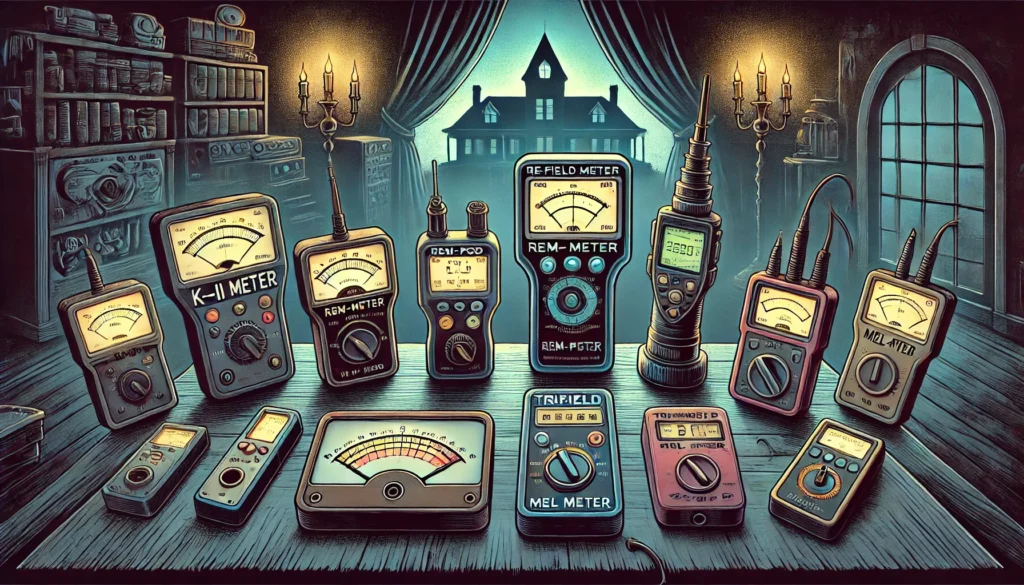
EMF meters have become synonymous with ghost hunting, and while they weren’t originally created for paranormal investigation, these devices have been adapted and embraced by investigators for their supposed ability to detect spiritual energy. Let’s take a look at the different types of EMF meters used by ghost hunters and how each one contributes to an investigation.
K-II Meter
The K-II meter is perhaps the most well-known EMF detector used in ghost hunting, thanks in part to its frequent appearances on paranormal TV shows like Ghost Hunters. Originally designed for electricians to detect electromagnetic interference, the K-II meter has since become popular among ghost hunters for its ease of use and ability to provide real-time readings.
How It Works: The K-II meter displays EMF levels using an LED array that lights up from green (low) to red (high), giving users a quick and easy way to observe changes in electromagnetic fields.
In Ghost Hunts: Investigators often ask questions aloud and look for the meter to spike in response, interpreting this as communication. This approach, called “communication sessions”, is often used to try to establish contact with spirits in real-time.
Pros and Cons: The simplicity of the K-II meter makes it a great beginner tool, but it can be prone to interference from nearby electronic devices. Ghost hunters must be vigilant about ruling out false positives caused by cell phones or radio signals.
TriField Natural EM Meter
The TriField Natural EM Meter was one of the first meters designed specifically for detecting “natural” electromagnetic fields—those not produced by human-made devices. Paranormal researchers often turn to this meter because it can detect both magnetic and electric field disturbances, and it’s calibrated to pick up changes that might be overlooked by standard EMF meters.
How It Works: This meter differentiates between natural and man-made sources of EMF, making it more reliable for ghost hunters who want to eliminate artificial interference from their readings.
In Ghost Hunts: The TriField meter is used to establish baseline readings and look for anomalies that can’t be explained by common sources. If an area suddenly shows a magnetic spike that doesn’t correlate with wiring or appliances, ghost hunters may interpret this as paranormal activity.
Pros and Cons: Its ability to filter out man-made signals gives this meter a level of credibility in investigations, but it’s also more complex to use and requires a greater understanding of EMF sources.
REM Pod
The REM Pod is a popular EMF detection tool in paranormal circles, designed specifically for ghost hunting. The REM-Pod uses an antenna to create its own electromagnetic field and emits an alert when this field is disturbed.
How It Works: The REM-Pod’s antenna emits an EM field, and if something disrupts that field—whether it’s a physical object or potentially a spirit—the device lights up and emits a tone. This makes it easier for ghost hunters to determine when something is interacting with the environment.
In Ghost Hunts: REM-Pods are often used as “trigger objects.” Investigators place the REM-Pod in areas where paranormal activity is reported, then wait for a response. They may use verbal prompts to encourage spirits to interact with the device.
Pros and Cons: The visual and auditory alerts make it highly engaging for ghost hunters, but it can also be triggered by mundane factors, like pets or wind. Investigators need to be mindful of environmental conditions when interpreting results.
MEL Meter
The MEL meter is another tool that’s gained popularity among ghost hunters because it combines several features into one. The MEL meter not only measures EMF but also records ambient temperature, which is helpful in ghost hunting because temperature drops are often associated with paranormal events.
How It Works: The MEL meter provides real-time EMF readings and can measure temperature simultaneously. This makes it possible to detect EMF changes while also observing any “cold spots,” which are often considered signs of ghostly presence.
In Ghost Hunts: Investigators use the MEL meter to identify correlations between EMF spikes and sudden temperature changes, believing that these combined anomalies may indicate an entity’s presence.
Pros and Cons: Having multiple features in one device makes it a versatile tool for investigators, but it also means that users need to understand how to interpret both types of data and recognize non-paranormal causes for changes.
Multi-Sensor Tools
Advancements in technology have led to the creation of multi-sensor tools designed specifically for ghost hunting. These devices often combine EMF detection with other sensors, such as motion detection, humidity, and even geophones, which detect vibrations.
How They Work: Multi-sensor tools allow investigators to observe multiple environmental changes simultaneously. For example, if an EMF spike is accompanied by a vibration detected by a geophone, this combination might suggest an entity moving through a space.
In Ghost Hunts: These tools help provide a broader picture of the environment, making it easier to correlate multiple phenomena, which may lend more credibility to claims of paranormal activity.
Pros and Cons: While multi-sensor tools are powerful, they are also more expensive and require a better understanding of various environmental conditions. Investigators need to know how to interpret the different data points accurately.
Establishing Baseline Readings
One of the first steps in using these tools during an investigation is to establish a baseline EMF reading. Ghost hunters take initial measurements throughout the location to determine normal EMF levels. This helps to identify any unusual spikes later that might be attributed to paranormal activity rather than a known source like a breaker box or a refrigerator.
Triggering Responses with EMF Tools
Many ghost hunters also use EMF meters to try to communicate with spirits in real-time. For example, they may ask yes-or-no questions and request that spirits “light up” the device for “yes” or “no.” This kind of interaction is known as ITC (Instrumental Trans-Communication), and it’s one of the most exciting uses of EMF meters for many investigators.
Challenges with EMF Meters
While EMF meters are a fundamental tool in ghost hunting, they are not without their challenges. False positives are common, often caused by electronic devices, faulty wiring, and even underground pipes. To ensure accuracy, investigators need to account for all potential sources of interference and focus on patterns that cannot be explained by conventional means.
While the use of EMF tools is popular, it is important to remember that their results are not definitive proof of paranormal activity. However, by combining EMF data with other evidence—such as EVPs (electronic voice phenomena), video, and eyewitness accounts—ghost hunters build a body of data that they believe can point to genuine paranormal events.
Potential False Positives
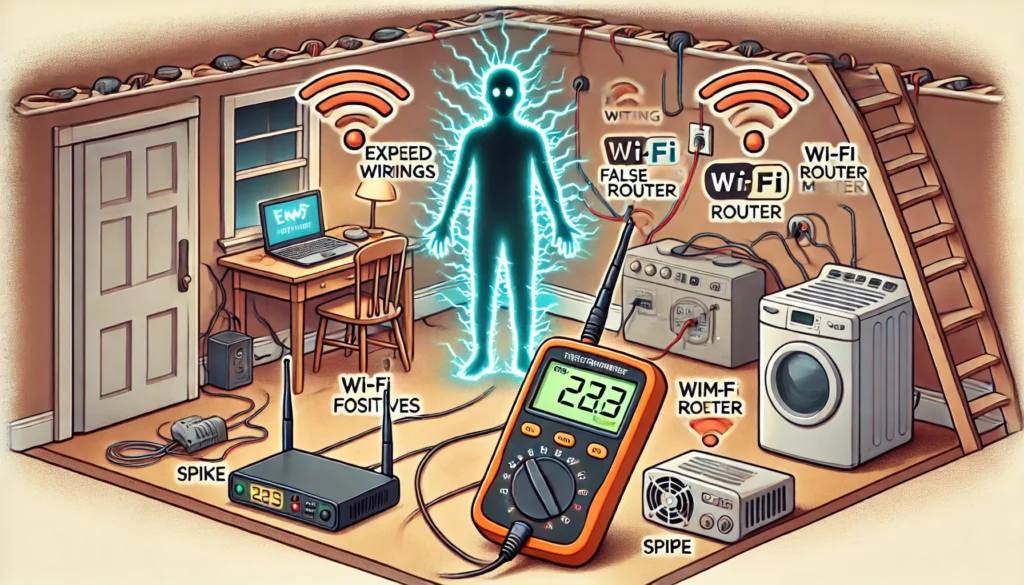
One of the biggest challenges in using electromagnetic field (EMF) meters during ghost hunts is the risk of false positives. Ghost hunting is all about looking for anomalies—changes in an environment that can’t be easily explained. But with electromagnetic fields, not all changes are supernatural. In fact, most spikes detected by EMF meters can usually be attributed to very mundane, earthly sources. Understanding and avoiding false positives is crucial to having credible ghost hunting investigations.
Common Sources of False EMF Readings
Electrical Wiring and Appliances
One of the most frequent causes of EMF spikes during investigations comes from faulty or unshielded electrical wiring. Any building with older or improperly grounded wiring can produce significant EMF fluctuations. For example, a faulty breaker box, exposed wires, or outdated power outlets can create random EMF “spikes” that ghost hunters might interpret as paranormal activity.
Appliances are also common culprits. Anything from a refrigerator to a microwave oven can create EMF fields, especially when running. Even small devices like phone chargers can cause readings to jump, which is why it’s important for ghost hunters to turn off or unplug electronic devices when possible during an investigation.
Cell Phones and Radio Signals
Cell phones, walkie-talkies, and other wireless communication devices are often used by ghost hunters during investigations to stay connected, but these same devices can inadvertently interfere with EMF meters. Cell phones in particular emit electromagnetic fields that can cause readings to spike, even when they aren’t being used for calls.
Radio towers and other broadcast equipment can also create EMF disturbances that may be picked up by meters, especially if an investigation is happening close to these sources. The strength and distance of these signals can vary, leading to unpredictable fluctuations.
Man-Made Environmental Factors
High-voltage power lines and electrical substations can emit strong EMFs over a considerable distance, and these can impact readings without investigators being aware of the source. When ghost hunters investigate an outdoor location, they need to keep an eye on their surroundings to make sure they aren’t close to any major power infrastructure that could explain EMF spikes.
Even vehicles can generate EMFs. The electrical components inside cars, such as the alternator and ignition system, produce electromagnetic fields, which can be detected if the investigation is happening near a road or parking area.
Natural Sources of Electromagnetic Interference
Certain minerals and natural geological formations can create localized electromagnetic fields. For instance, rocks that contain high concentrations of magnetite can interfere with EMF meters. Some paranormal researchers even believe that these natural EMF “hotspots” might contribute to the ghostly activity reported in certain locations, though this remains speculative.
Solar activity can also play a role in causing electromagnetic interference. During periods of high solar activity, the Earth’s magnetic field can be disturbed, which may create fluctuations in EMF readings. While this isn’t a typical factor in most ghost hunts, it’s important to note that natural cosmic events can impact the electromagnetic environment on Earth.
Environmental Control to Minimize False Positives
To minimize the risk of false positives, ghost hunters often take baseline readings. This means they walk through a location before starting their investigation to note all the existing electromagnetic “normal” levels. By understanding where electrical sources and natural anomalies are, they can better identify when a change in the environment may be due to something unexplained.
Ghost hunters also need to be aware of the influence of moving through or interacting with the environment. For example, walking too close to electrical outlets or bringing in electronic equipment can cause unexpected fluctuations. Teams often try to create an “electronics-free zone” during EVP (Electronic Voice Phenomenon) and EMF sessions to avoid cross-contamination.
Ghost Hunting Best Practices to Avoid False Readings

Identify and Document All Electrical Sources
Before beginning an investigation, it’s crucial to identify all possible sources of EMF, including electrical outlets, junction boxes, wiring routes, and fuse boxes. Noting these sources and keeping track of them can help distinguish between expected EMF fluctuations and potentially anomalous ones.
Investigators should also turn off unnecessary appliances and, if possible, work in a location with limited electronic interference to keep environmental factors under control.
Create Distance from Known Sources
Keeping a safe distance from known sources of electromagnetic interference is crucial for reducing false positives. For example, holding an EMF meter too close to a laptop or even other ghost hunting equipment can cause spikes that may mislead the investigation.
Investigators also often establish control points, areas within a room that they know should have stable EMF readings. They use these control points to double-check their meters during the investigation.
Repeat and Corroborate Readings
An EMF spike on its own isn’t typically enough evidence for a ghost hunter to declare an area haunted. Instead, investigators try to corroborate these readings with other forms of evidence, such as EVPs, temperature drops, or visual anomalies. If multiple types of equipment register changes simultaneously, that may increase the credibility of the finding.
Investigators also repeat readings in the same spot, preferably at different times. If an EMF spike can be recreated, it might indicate that a mundane environmental factor is causing the anomaly rather than a supernatural presence.
Examples of False Positives in Famous Investigations
Many famous paranormal investigations have run into the problem of false positives. For instance, the Amityville Horror house was initially believed to have high paranormal activity because of fluctuating EMF readings. However, later investigations revealed that poor wiring and malfunctioning electrical fixtures were the true culprits behind the mysterious spikes (Note: This is based on Joe Nickell’s thoughts on the phenomena).
Another example is the infamous Queen Mary ship, where ghost hunters have repeatedly documented high EMF readings. It was later found that the electrical systems running throughout the decommissioned cruise liner caused much of the activity, emphasizing the importance of eliminating possible everyday sources of EMF before attributing them to ghosts (Note: This is based on Richard Wiseman’s thoughts on the issue).
Why False Positives Matter
The thrill of ghost hunting often hinges on the excitement of witnessing something unexplained. However, failing to account for false positives can lead to misinformation and false conclusions about the paranormal. By understanding the limitations of EMF equipment and recognizing the potential for non-paranormal explanations, ghost hunters can improve the credibility of their findings and bring a more scientific approach to their investigations.
False positives are a reminder that ghost hunting isn’t just about seeking the extraordinary—it’s also about eliminating the ordinary. The goal is to narrow down the possibilities until only the truly unexplained remains, making those potential moments of contact with the unknown even more powerful.
Practical Tips for Using EMF Meters in Investigations
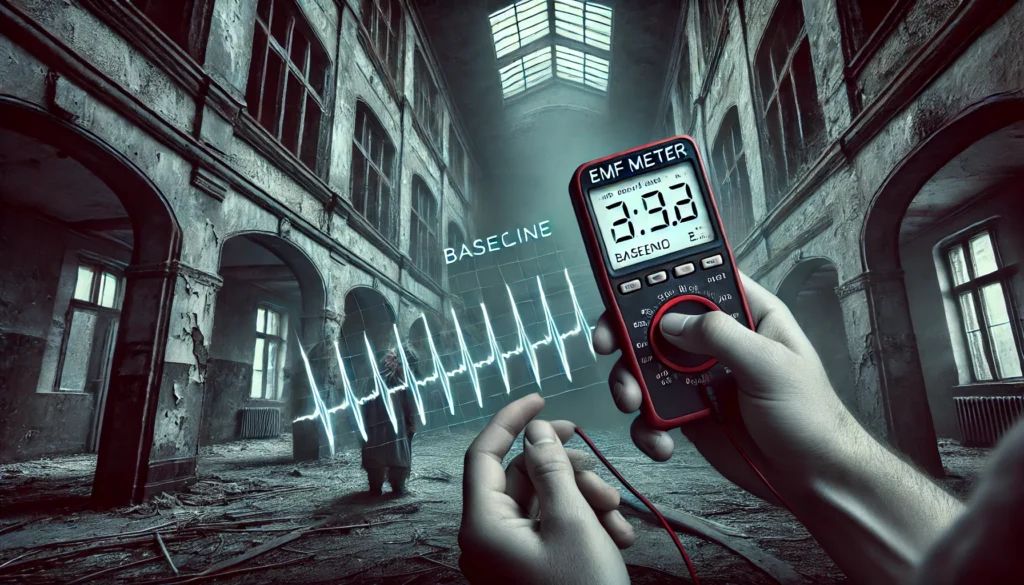
While skepticism abounds regarding the use of electromagnetic field (EMF) meters in ghost hunting, these tools are still valuable when used correctly. Whether you’re a beginner ghost hunter or an experienced investigator, understanding how to maximize the potential of EMF meters during an investigation can help you distinguish between natural electromagnetic sources and possibly paranormal ones. Below are practical tips on how to effectively use EMF meters in a ghost hunt.
Establish Baseline Readings
One of the first steps of any ghost investigation should be to establish baseline EMF readings. These baseline readings are taken before any paranormal activity is expected, and they provide a reference for what normal electromagnetic levels are in each area of the location.
How to Take Baseline Readings: Start by walking through each room or area of your investigation site while using your EMF meter. Note the average readings for each location, paying special attention to any areas with elevated EMF levels. Be sure to document any high readings that are near obvious sources, like electrical panels, appliances, or large pieces of electronic equipment.
Use a Notebook or Digital Recorder: Record baseline readings and note the areas where spikes occurred so that you can avoid misinterpreting those spots as paranormal later on. Keeping a detailed log will help you identify what’s normal for the space and make it easier to detect any anomalies that appear later.
Minimize Electromagnetic Interference
To reduce false positives, it’s important to minimize sources of electromagnetic interference whenever possible.
Turn Off Electronics: Unplug or turn off electronic devices such as televisions, radios, and Wi-Fi routers if you can do so without compromising safety. This will help ensure that EMF readings aren’t influenced by the electronics you control.
Keep Cell Phones in Airplane Mode: Cell phones can emit electromagnetic energy even when not actively being used. Putting them in airplane mode can help minimize any unwanted EMF interference that could give misleading readings.
Check the Environment: Be mindful of external sources that you might not be able to control, such as power lines outside the building or nearby radio towers. Knowing where these potential sources are will help you make informed decisions about your EMF readings.
Repeating Measurements for Verification
If you encounter an EMF spike during an investigation, it’s essential to verify the reading before attributing it to something paranormal.
Return to the Same Spot: Go back to the area where you detected a spike and attempt to take a reading again. If the spike can’t be replicated, it’s more likely to have been a random or one-off occurrence, possibly due to interference.
Move in a Systematic Manner: Move the EMF meter slowly and systematically through the space, both horizontally and vertically, to ensure that you capture any variations accurately. Avoid quick, jerky movements, as these can cause unreliable readings.
Cross-Reference Data with Other Devices
To strengthen your evidence, use multiple tools simultaneously. EMF meters alone are not sufficient proof of a haunting, but correlating EMF spikes with other phenomena may suggest something more significant.
Pair EMF with Audio Recorders: Record audio using EVP (Electronic Voice Phenomenon) recorders at the same time you are monitoring EMF. If an EMF spike coincides with an unusual sound or voice, this could add weight to your findings.
Temperature Sensors: Many ghost hunters believe that cold spots can accompany paranormal activity. Using a temperature gun or thermometer to detect sudden drops in temperature at the same time as an EMF spike can provide additional data that supports a paranormal claim.
Ask Spirits to Interact
Many ghost hunters use EMF meters not just as passive devices but as part of an interactive session where they try to communicate directly with spirits.
Direct Questions: Ask yes-or-no questions, and invite the spirit to interact with the EMF meter to indicate an answer. For example, you might say, “If there is anyone here with us, please make the lights on this meter change.” If the EMF meter responds, ask follow-up questions to try to establish a pattern of intelligent responses.
Be Patient: Interaction sessions can take time, and you may not always get an immediate response. It’s important to stay patient and consistent when attempting to use the EMF meter as a communication tool. Be mindful of ambient sources and avoid assuming every fluctuation is a response.
Control for Human Factors
Sometimes, simple human factors can affect an EMF meter’s readings. Handling EMF meters incorrectly or having people too close to them can cause misleading fluctuations.
Hold the Meter Properly: EMF meters are sensitive to electromagnetic interference, which can be affected by static electricity or the natural electromagnetic field generated by your own body. Hold the meter in a stable manner, preferably away from your body, and avoid touching the antenna or sensor if the device has one.
Limit the Number of People Nearby: Try to keep a minimal number of people in the immediate vicinity of the EMF meter. Large groups can bring additional variables, such as electronic devices or even static buildup from clothing, that can affect readings.
Time of Day and Environmental Conditions
Ghost hunters often believe that certain times or environmental conditions can make it easier to detect paranormal activity. Using EMF meters under these circumstances may yield more interesting results.
Night Investigations: Many investigators conduct their hunts at night, not because ghosts only come out after dark, but because ambient EMF noise tends to be lower—fewer appliances are running, and there is less electronic interference.
Weather Conditions: Some paranormal researchers think that electrical storms or high humidity levels might help spirits manifest. If you’re using an EMF meter during such conditions, be extra cautious about ruling out natural sources of electromagnetic interference, since these conditions can also produce electrical fluctuations unrelated to ghosts.
Use Multiple EMF Meters
Using more than one EMF meter can help validate findings. If only one meter detects a fluctuation while another placed nearby does not, it’s more likely that the reading is a false positive rather than a paranormal event.
Distance Between Devices: Place the meters in different locations to establish coverage over a broader area, but keep them close enough that if something significant happens, it will be picked up by more than one device. This approach helps rule out faulty equipment or single-device anomalies.
Simultaneous Monitoring: Monitor both meters at the same time. If both detect a spike simultaneously, it may suggest a genuine change in the electromagnetic environment, possibly indicating paranormal activity.
Don’t Jump to Conclusions
The thrill of ghost hunting can sometimes lead investigators to jump to conclusions, but it’s important to remain skeptical and methodical. Keep in mind that EMF meters are sensitive instruments designed to pick up any change in electromagnetic energy, not just ghosts. Every reading should be analyzed critically.
Document Everything: Record all findings, even if they seem insignificant. The goal is to gather as much data as possible so that you can review and analyze it later for patterns or inconsistencies.
Debunk Before You Believe: The best ghost hunters are those who try to debunk their own findings before declaring them paranormal. Investigate every possible mundane cause for EMF readings before considering the paranormal explanation.
Have Fun but Stay Safe
Ghost hunting is an exciting pursuit, but it’s also important to remain safe. When using EMF meters, make sure that you’re not in a location where high EMF exposure could be hazardous. Elevated EMF levels can, over time, cause health issues such as headaches, nausea, and dizziness. Always investigate with caution and awareness of your surroundings.
Conclusion
Using an EMF meter in ghost hunting is as much an art as it is a science. By understanding the strengths and limitations of these devices and following best practices, ghost hunters can minimize false positives and maximize their chances of capturing genuine paranormal data. Whether you’re hoping to contact the other side or simply curious about electromagnetic phenomena, approaching investigations with care and critical thinking will lead to the best—and potentially spookiest—results.
How do you use EMF meters on your investigations? What have you learned about them? Let me know in the comments below. Thanks for reading Ghostly Activities. Take care!
Sources
Habash, Riadh W. Electromagnetic Fields and Radiation: Human Bioeffects and Safety. Routledge, 2023.
Parsons, Steven T. Ghostology: The Art of the Ghost Hunter. White Crow Books, 2015.
Couch, Melissa Martin Ellis. The Everything Ghost Hunting Book: Tips, Tools, and Techniques for Exploring the Supernatural World. Adams Media, 2014.
Bagans, Zak. Ghost-Hunting For Dummies. For Dummies, 2019.
National Institute of Environmental Health Sciences. “Electric & Magnetic Fields.” National Institute of Environmental Health Sciences, 2023, www.niehs.nih.gov/health/topics/agents/emf/.
“Michael Persinger.” Wikipedia, Wikimedia Foundation, 12 Nov. 2023, en.wikipedia.org/wiki/Michael_Persinger.
Persinger, Michael. ELF and VLF electromagnetic field effects. Plenum Press, 1974.
Wiseman, Richard. Paranormality: Why We See What Isn’t There. Pan Books, 2013.
Radford, Benjamin. Investigating Ghosts: The Scientific Search for Spirits. Committee for Skeptical Inquiry, Rhombus Publishing, 2018.
Underwood, Peter. The Ghost Hunter’s Guide. Underwood Publishing, 2018.
“Trifield – EMF Meters.” Trifield, AlphaLab, Inc., 2023, www.trifield.com/.
“REM Pod EMT.” Pro Measure, 2023, www.pro-measure.com/REM_Pod_EMT_p/021487-rem-pod-emt.htm.
Biddle, Kenny. “Ghost-Hunting Gadgets: The REM Pod.” Skeptical Inquirer, 6 Oct. 2021, skepticalinquirer.org/exclusive/ghost-hunting-gadgets-the-rem-pod/.
“Stone Tape Theory.” Wikipedia, Wikimedia Foundation, 23 Oct. 2023, en.wikipedia.org/wiki/Stone_Tape_theory.
Massullo, Brandon. The Ghost Studies: New Perspectives on the Origins of Paranormal Experiences. Visible Ink Press, 2017.
“Electromagnetic Field.” Wikipedia, Wikimedia Foundation, 10 Nov. 2023, en.wikipedia.org/wiki/Electromagnetic_field.
“Electromagnetic Radiation and Health.” Wikipedia, Wikimedia Foundation, 5 Nov. 2023, en.wikipedia.org/wiki/Electromagnetic_radiation_and_health.
